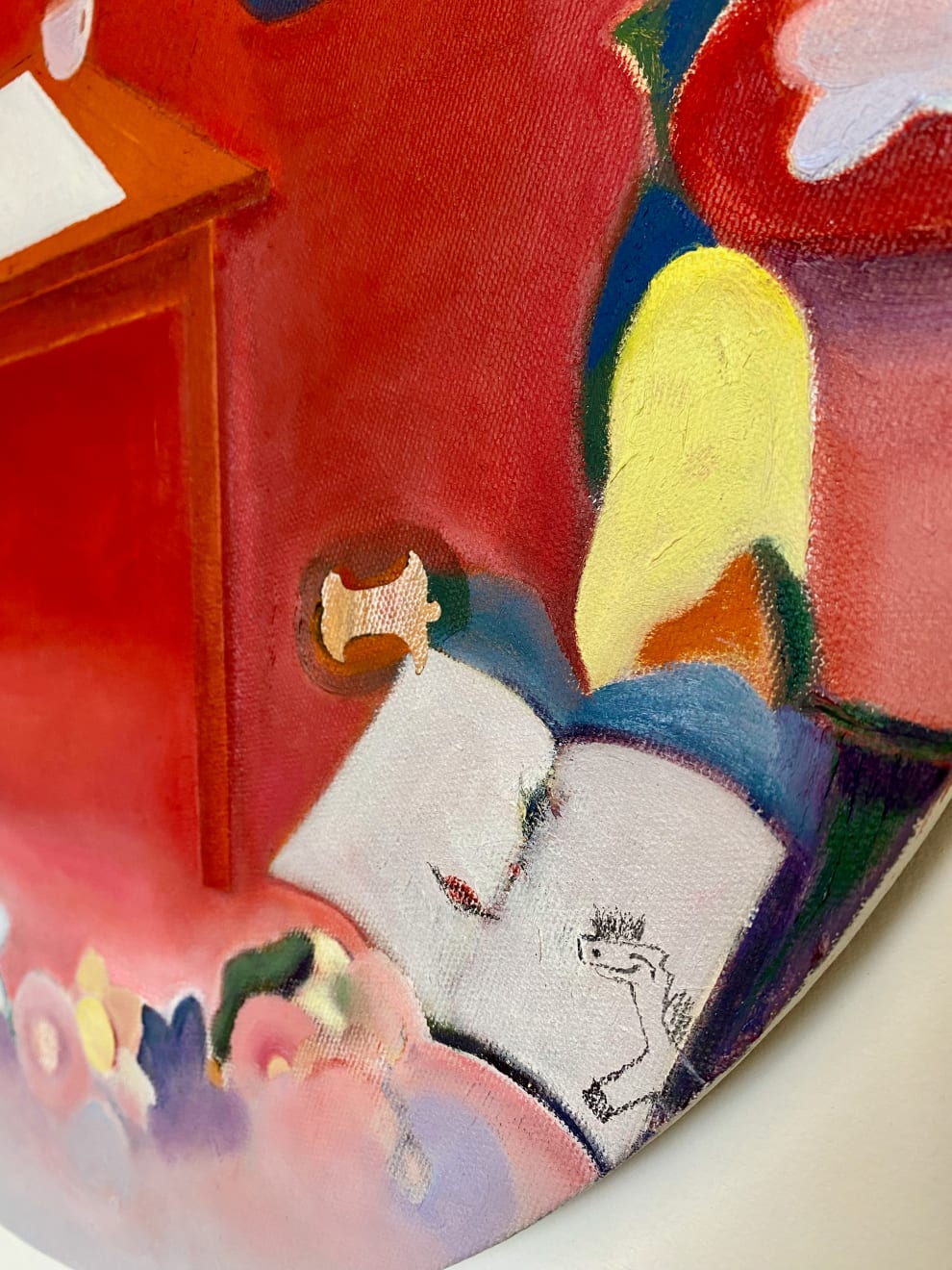In Kyoung Chun
Interior with blank paper, 2022
Oil on canvas
20 in diameter / 50.8 cm diameter
IKC0006
Further images
Text by Yoon Nam's, from the author’s 2022 essay 'What Remains as Openness: Contiguous Interiority of In Kyoung Chun’s Flowering Time' A red circular canvas on an easel first caught...
Text by Yoon Nam's, from the author’s 2022 essay "What Remains as Openness: Contiguous Interiority of In Kyoung Chun’s Flowering Time"
A red circular canvas on an easel first caught my eye when I entered her studio. At first glance from a distance, it appeared circular and red, with a blank space in the middle, like a flower—but once closer, the edge of the red circle became lined with an array of flowers, books, and miscellaneous personal items. In the center of the circle, next to painting implements, a light fixture hangs above a blank piece of paper sitting on a desk. Chun said that the piece was about working late at night, painting at her desk, alone, staring at the blank paper. Working alone, late, night, blank - these are ubiquitous words for a lot of artists. The recurring subject matter incorporating books, ceramics, fruits, flowers, painting implements, and other various personal items in Chun’s oil and watercolor paintings recalls the still-life painting genre that emerged in late eighteenth-century Korea (in the Joseon period, 1390s-1910) called 문방도 (pronounced “Moonbangdo”). Moonbangdo means a painting of a scholar’s stationery or a scene of study. Most Moonbangdo scenes feature the objects alone, arranged in a certain way, like depicting stacked books next to other objects found in a study or a panoramic view of bookshelves filled with writing (calligraphy) implements. Its subject matter spans items of both personal and social value, reflecting the scholar’s own philosophic and aesthetic ideals as well as the contemporaneous historical and socioeconomic atmosphere. Most interestingly, the subject matter in Moonbangdo can be historically incongruent, both imaginary and real. In Chun’s paintings, the quintessential common objects of an artist’s studio merge with other items displaying a personal story and affection. This mixture, quietly but imminently, draws the audience into the ideal and historical interior space the artist opens up for the viewer.
In addition to the artist’s working space, Chun’s lucent paintings portray her private and domestic surroundings, including a lived-in bedroom or a small dining table by the window. The recurring mix of the two themes—quotidian delights and work routines—illustrate the artist’s penchant for interpreting domestic joy and comfort as a gift that garners and opens to the creative resurgence. With a cursory look, the mix can seem blithe, but these objects swirl like a flurry or a vortex in her paintings, manifesting into an auspicious symbolism of creativity raptured in ordinary objects. The banal, routine moments in our lives and day-to-day practice rise to creative moments; it makes us question the lure of the ingenious artist, of art as an exile to the extraordinary.
A red circular canvas on an easel first caught my eye when I entered her studio. At first glance from a distance, it appeared circular and red, with a blank space in the middle, like a flower—but once closer, the edge of the red circle became lined with an array of flowers, books, and miscellaneous personal items. In the center of the circle, next to painting implements, a light fixture hangs above a blank piece of paper sitting on a desk. Chun said that the piece was about working late at night, painting at her desk, alone, staring at the blank paper. Working alone, late, night, blank - these are ubiquitous words for a lot of artists. The recurring subject matter incorporating books, ceramics, fruits, flowers, painting implements, and other various personal items in Chun’s oil and watercolor paintings recalls the still-life painting genre that emerged in late eighteenth-century Korea (in the Joseon period, 1390s-1910) called 문방도 (pronounced “Moonbangdo”). Moonbangdo means a painting of a scholar’s stationery or a scene of study. Most Moonbangdo scenes feature the objects alone, arranged in a certain way, like depicting stacked books next to other objects found in a study or a panoramic view of bookshelves filled with writing (calligraphy) implements. Its subject matter spans items of both personal and social value, reflecting the scholar’s own philosophic and aesthetic ideals as well as the contemporaneous historical and socioeconomic atmosphere. Most interestingly, the subject matter in Moonbangdo can be historically incongruent, both imaginary and real. In Chun’s paintings, the quintessential common objects of an artist’s studio merge with other items displaying a personal story and affection. This mixture, quietly but imminently, draws the audience into the ideal and historical interior space the artist opens up for the viewer.
In addition to the artist’s working space, Chun’s lucent paintings portray her private and domestic surroundings, including a lived-in bedroom or a small dining table by the window. The recurring mix of the two themes—quotidian delights and work routines—illustrate the artist’s penchant for interpreting domestic joy and comfort as a gift that garners and opens to the creative resurgence. With a cursory look, the mix can seem blithe, but these objects swirl like a flurry or a vortex in her paintings, manifesting into an auspicious symbolism of creativity raptured in ordinary objects. The banal, routine moments in our lives and day-to-day practice rise to creative moments; it makes us question the lure of the ingenious artist, of art as an exile to the extraordinary.







